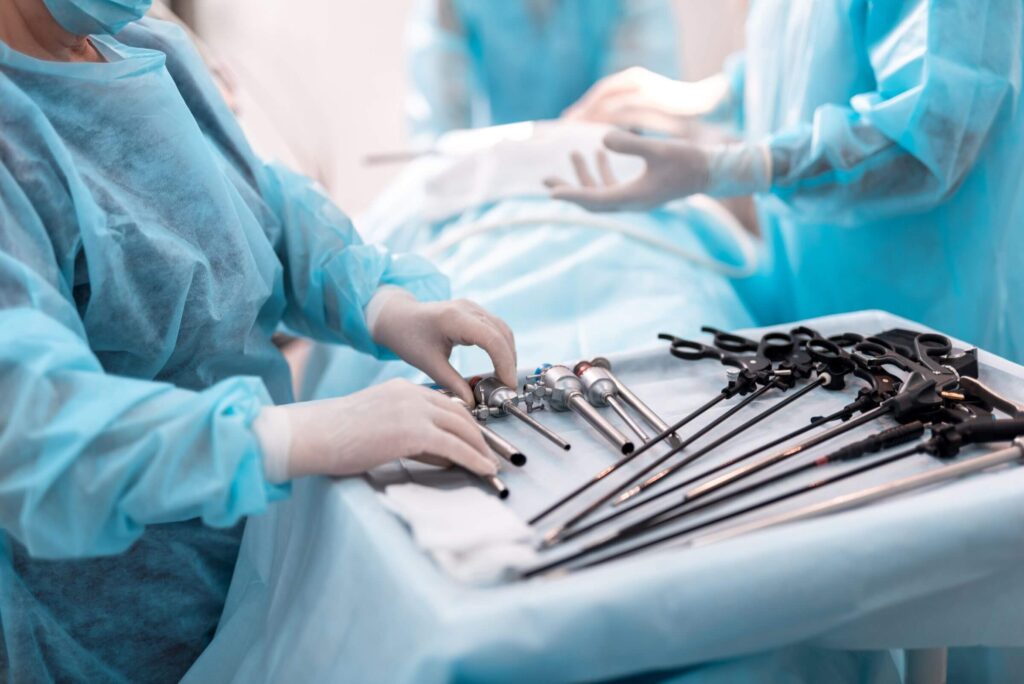Collaborative Specialties
Minimally Invasive Gynecological Surgery (MIGS)
What is Minimally Invasive Surgery (MIGS)?
Minimally Invasive Gynecologic Surgery (MIGS) refers to advanced surgical techniques used in gynecology that are less invasive than traditional surgeries. These procedures utilize minimally invasive approaches, such as laparoscopy and robotic surgery, to address issues related to fertility. MIGS specialists are fellowship-trained skilled surgeons who are highly skilled in performing these surgeries. MIGS typically allows patients to recover quicker with fewer or no incisions and less pain.

Benefits of Minimally Invasive Approaches
MIGS offers several benefits over traditional open surgeries. Patients can expect reduced recovery time, minimal scarring, and a quicker return to normal activities. The precision and effectiveness of Minimally Invasive Gynecologic Surgery contribute to improved outcomes and an overall enhanced patient experience.
- Quicker Recovery Time
- Less Pain
- Minimal Scarring
- Less Chance of Infection
- Less Bleeding
- Reduced Trauma to Body
- Less Medication
- Smaller Incisions
Types of Minimally Invasive Reproductive Surgeries
Hysteroscopy
Hysteroscopic Surgery is used for diagnosing and addressing the underlying factors of abnormal uterine bleeding, fibroids, polyps, uterine septum, scar adhesions, etc. A surgeon uses a hysteroscope—a thin illuminated tube—which is inserted through the cervix and into the uterus. Equipped with a camera, the hysteroscope provides direct visualization of the uterus, allowing for the identification of any abnormalities without making any incisions.
Laparoscopy
Laparoscopic Surgery involves the insertion of a laparoscope—a narrow tube with a camera attached—through small incisions made on the abdomen. This approach allows direct visualization of the pelvic organs, allowing the surgeon to identify any complications and irregularities. Conditions such as fibroids, scar tissue, endometriosis, and blocked fallopian tubes, which may contribute to infertility, can be diagnosed through this less invasive procedure.
Robotic-Assisted Laparoscopy
Robotic-Assisted Laparoscopy involves a robotic system, which is comprised of a console that provides magnified, high-resolution 3D images of the surgical field. The surgeon maneuvers the robotic arms, which are inserted through small keyhole incisions made in the abdomen. Each robotic arm is equipped with specialized surgical instruments, to conduct laparoscopy.
Pre- and Post-Operative Care for MIGS
Each patient’s care plan for Minimally Invasive Gynecologic Surgery (MIGS) is tailored to their specific needs, the type of surgery performed, and any underlying health conditions. RFC provides a network of specialists including surgeons, nurses, physiotherapists, and even nutritionists ensuring that each patient receives comprehensive care without the need to worry about finding specialists on their own.
Pre-Operative Support and Care
-
Assessment and Diagnosis
Prior to surgery, thorough medical and gynecological evaluations are conducted. This may include physical exams and imaging tests like ultrasounds and MRIs.
-
Patient Education
Patients are given detailed information about the procedure, expected outcomes, potential risks, and recovery process. Understanding the surgery helps reduce anxiety and concerns.
-
Health Optimization
Ensuring the patient is in the best possible health before the surgery is vital. This could involve managing chronic conditions, adjusting current medications, and advising on nutrition and lifestyle changes.
-
Fasting and Bowel Preparation
Depending on the type of surgery, patients may be advised to fast and undergo bowel preparation to reduce the risk of complications.
-
Medication Management
Certain medications, especially blood thinners or anti-inflammatory drugs, might need to be adjusted or temporarily stopped.
Post-Operative Support and Care
-
Pain Management
While MIGS results in less pain and quicker recovery, effective pain control is crucial. This often involves medications, and sometimes techniques like nerve blocks or epidural analgesia.
-
Wound Care
Instructions on caring for incisions to prevent infection and promote healing will be given to patients to ensure optimal healing and minimal scarring.
-
Physical Activity Guidelines
Patients are generally encouraged to engage in light activities soon after surgery to promote circulation and prevent complications like blood clots. However, heavy lifting or strenuous activity is usually restricted for a period.
-
Diet and Nutrition
Initially, a light diet may be recommended. Hydration and balanced nutrition aid in recovery.
-
Follow-up Appointments
Regular follow-up is important to monitor healing, address any complications, and discuss the return to normal activities.
-
Emotional Support
Recovery can be both physically and emotionally challenging. Support from healthcare providers, counseling, and support groups can be beneficial.

